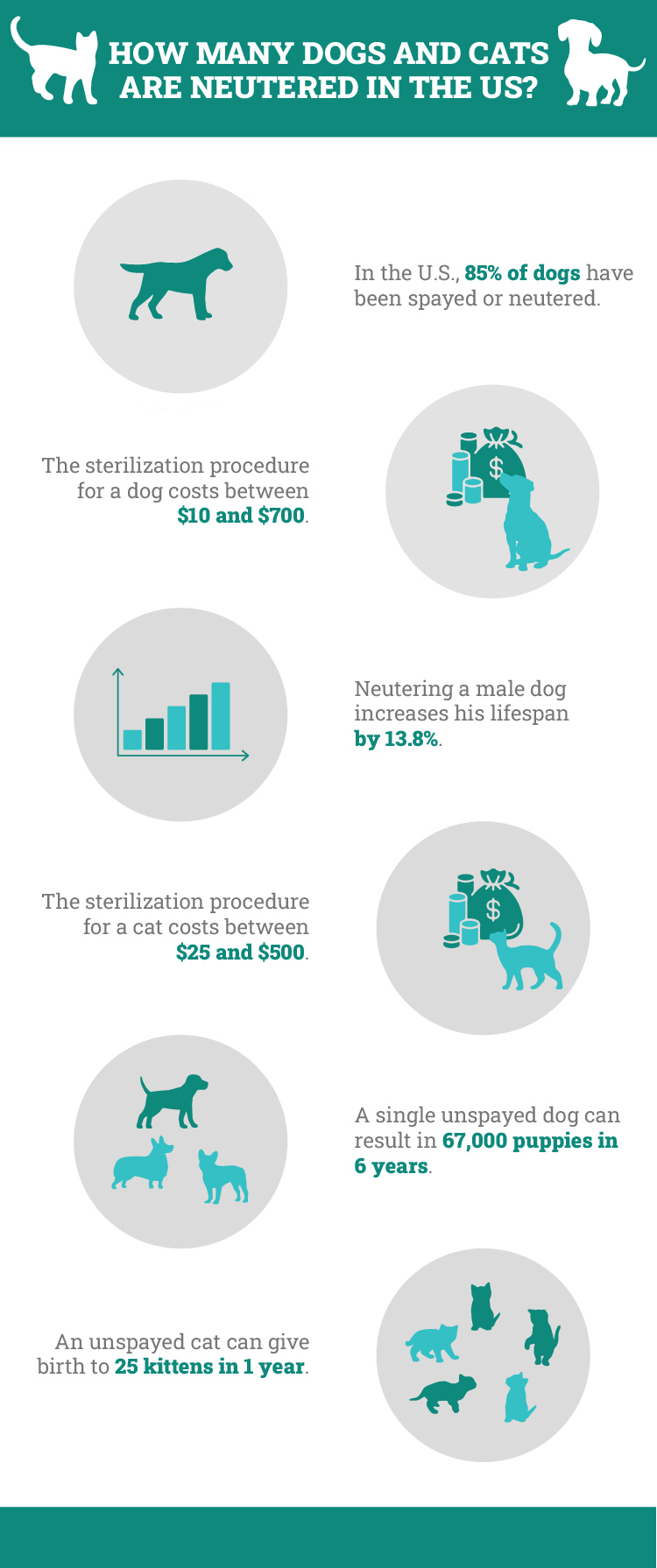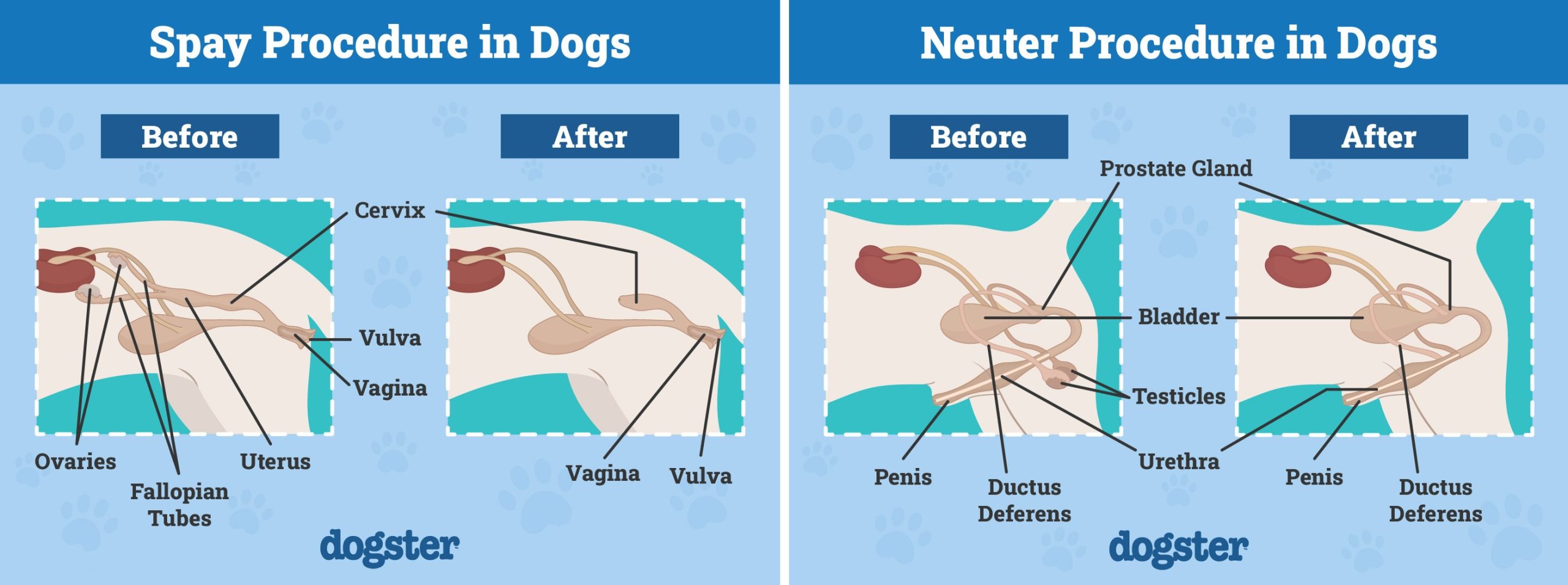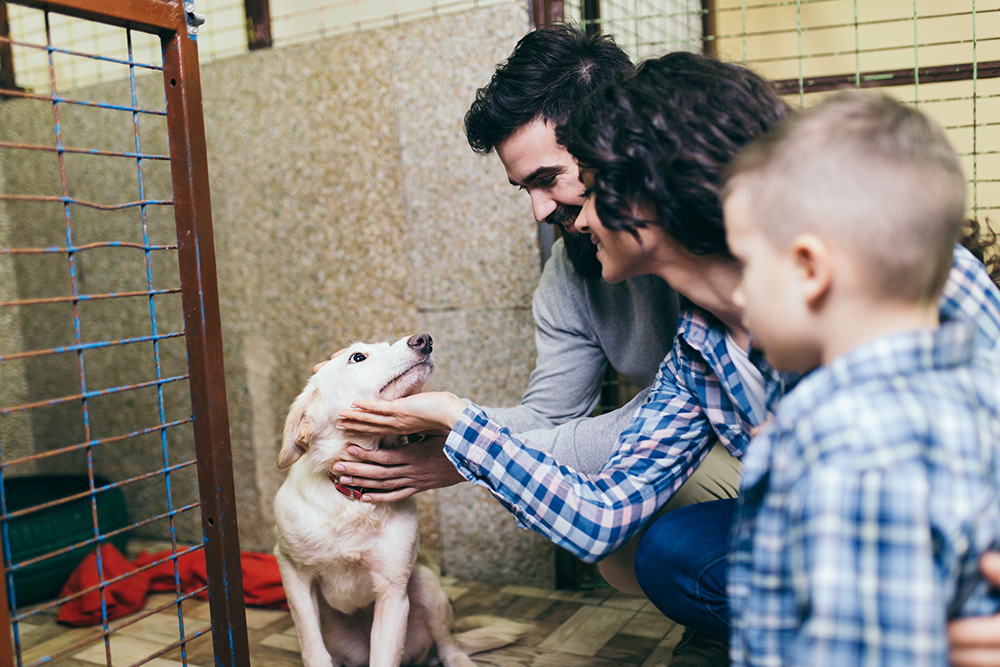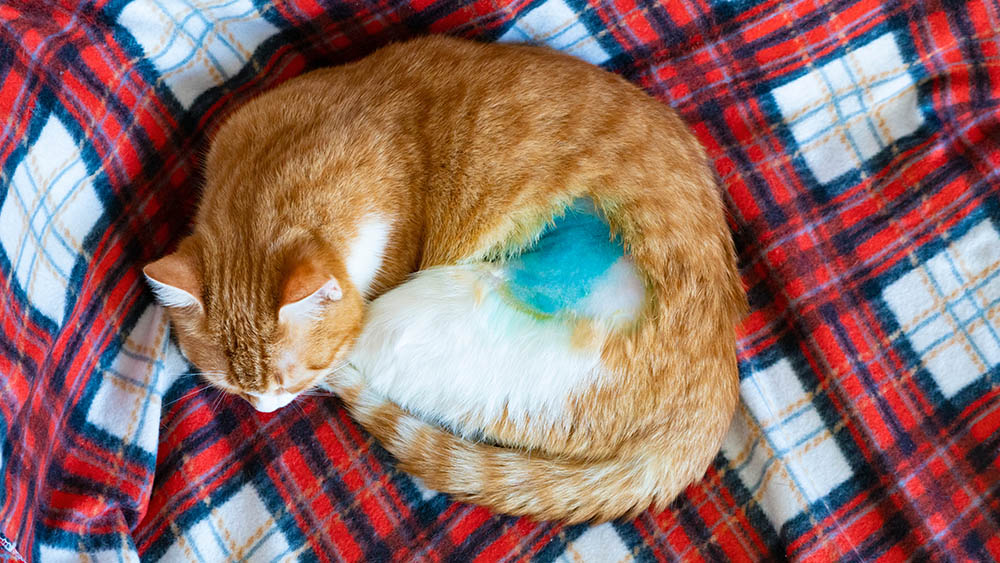In this article
Note: This article’s statistics come from third-party sources and do not represent the opinions of this website.
Most vets recommend it, and animal shelters and rescues certainly welcome it, but the topic of spaying and neutering pets is still somewhat debated. That said, roughly 80–90% of owned dogs and cats in the U.S. have been spayed or neutered.1 With an estimated pet population of 89.7 million dogs and 73.8 million cats,2 that means an average of around 70 million dogs and 60 million cats are sterilized in the U.S. The percentage of sterilized dogs is slightly lower than that of cats.
Keep in mind pet ownership is a dynamic statistic and precise figures are difficult to pin down.
Opponents claim that the procedure carries complications that can increase the risk of certain health conditions. Those who wish to breed their pets, of course, stand firmly against the idea of sterilizing their animals.
Proponents say that spaying or neutering prolongs a pet’s life by reducing illnesses like testicular or ovarian cancer and that it can improve and even eradicate behavioral problems.
Here, we have gathered relevant statistics regarding the debate, so you can make an informed decision on what is best for your pet and for you.

The 11 Neutering and Spaying Statistics
- In the U.S., roughly 85% of dogs have been spayed or neutered.
- The sterilization procedure for a dog costs between $10 and $700.
- Neutering a male dog increases his lifespan by 13.8%.
- Early sterilization of dogs does carry health risks.
- 32 states legally require adopted dogs to be sterilized.
- The sterilization procedure for a cat costs between $25 and $500.
- Early neutering of cats carries minimal health risks.
- 80% to 90% of owned cats and dogs in the U.S. are sterilized.
- There are 40.9 million stray cats and dogs in the U.S.
- A single unspayed dog can result in 67,000 puppies in 6 years.
- An unspayed cat can give birth to 25 kittens in 1 year.


Spaying and Neutering Dogs Statistics
1. In the U.S., 85% of dogs have been spayed or neutered.
(DogCancer.com)
Neutering or castrating is the process in which both of a male dog’s testicles are removed, while spaying entails the removal of a female dog’s ovaries and uterus. Collectively, the name for these procedures is sterilization or sometimes, “fixing.” Although precise numbers are not known because the exact canine population is unknown and not all sterilization procedures are reported, it is estimated that 85% of dogs in the U.S. have been spayed or neutered.

2. The sterilization procedure for a dog costs between $10 and $700.
(Money)
The cost of sterilization is determined by several factors, but the biggest determinant is the sex of the dog. The spaying procedure is riskier and carries more potential complications, so it’s more expensive. Low-cost services are available in most cities and areas.
3. Neutering a male dog increases his lifespan by 13.8%.
(DogCancer.com)
One of the benefits of having a dog sterilized is the fact that on average, fixed dogs live longer than intact dogs. In fact, sterilized males live 13.8% longer, while spayed females live more than 26% longer. This could mean an extra 2- or 3-years’ difference from a spayed or neutered canine.

4. Early sterilization of dogs does carry health risks.
(Embrace Pet Insurance Agency)
Although it is generally accepted that spayed and neutered dogs live longer and healthier lives, certain health risks are associated with the process. In particular, certain sterilized breeds are more likely to develop conditions like hip dysplasia, especially if they were sterilized less than 12 months old. Most owners are advised to talk to their vet about having their dogs spayed or neutered at 6 months of age to see if they can be fixed at this point or if they should wait a few months or even a year.
5. 32 states legally require adopted dogs to be sterilized.
(Time)
Stray dogs are a major problem across the U.S., and so is the number of dogs left in the care of shelters and rescues. Sterilization is seen as an effective method of preventing a further rise in these numbers. As such, 32 U.S. states make it a legal requirement that dogs adopted from a rescue be sterilized.

Spaying and Neutering Cats Statistics
6. The sterilization procedure for a cat costs between $25 and $500.
(Betterpet)
The average cost of having a cat sterilized runs from as little as $25 to as much as $500. Factors that determine the cost are much the same for cats as they are for dogs in that the male operation costs less than that of the female, and certain grants and programs operate across the country that provide access to low-cost spaying and neutering.
7. Early neutering of cats carries minimal health risks.
(PetMD)
Neutering is a common procedure in veterinary medicine and is generally accepted to be safe. Unlike with dogs, the negative effects of the surgery for cats are quite minimal, and most kittens are fixed between 8 weeks and 6 months old. That said, the risks aren’t zero, and if a kitten is neutered before that 8-week mark, they may have stunted urethral growth and be predisposed to having urinary issues later.


Other Spaying and Neutering Statistics
8. 80% to 90% of owned cats and dogs in the U.S. are sterilized.
(HumanePro)
The massive push for sterilization by animal welfare organizations and veterinary professionals for the past few decades has been part of an attempt to reduce the numbers of homeless dogs and cats. It has been quite successful, with 80%–90% of these animals being neutered or spayed. There are still many strays out there, however, so sterilization advocacy continues.
9. There are 40.9 million stray cats and dogs in the U.S.
(Mars)
There is no way to know for sure how many stray dogs and cats are on the streets at any time, but it is estimated that the number is over 40 million (5.9 million dogs and 35 million cats). While this is a huge number, the good news is that it has been slowly decreasing over the years, and the U.S. currently has a below-average level of overall pet homelessness.

10. A single unspayed dog can result in 67,000 puppies in 6 years.
(North Shore Animal League America)
A single unspayed female dog and all of her resulting offspring can lead to 67,000 puppies being born in just 6 years. Those are many potentially homeless puppies that could have been prevented with a single spaying operation.
11. An unspayed cat can give birth to 25 kittens in 1 year.
(24Petwatch)
An unspayed cat can have as many as 25 kittens in a single year, and she and her offspring can produce a staggering 370,000 kittens in 7 years. This is the main reason that there are so many more homeless cats than dogs, along with the fact that many cats that are now spayed already had kittens before the procedure was done.


Frequently Asked Questions
Is Spaying and Neutering Cruel?
Opponents of spaying and neutering claim that sterilization deprives an animal of their basic rights and their basic need to reproduce. Proponents point to the tens of millions of stray animals. The procedure itself is done under an anesthetic, so the animal doesn’t feel a thing, but there are always risks associated with surgical procedures. There is no straightforward answer to this question and the debate will likely continue.
What Are the Benefits of Sterilization?
- Minimize the increasing number of unwanted cats and dogs that end up on the streets or in already overcrowded shelters and rescue centers
- Prolong an animal’s life by reducing the risk of developing certain cancers and other conditions
- Stop unwanted behaviors, such as aggression in dogs and spraying in cats
- Save owners the work and the cost of having unexpected litters of puppies and kittens that can be difficult to sell or give away

What Are the Cons of Sterilization?
Some dogs and cats react badly to the anesthesia that is given for the procedure, and there is evidence to suggest that certain breeds of dogs are more likely to develop conditions like hip dysplasia if they are spayed or neutered under the age of 12 months.
What Do Vets Say About Sterilization?
In general, veterinarians recommend spaying or neutering, though there are specific circumstances when they may caution against it, usually due to an underlying health condition in your pet. Always consult with your vet before making the final decision.
When Should You Get a Dog Sterilized?
For years, it has been recommended that female dogs be spayed at 6 months to avoid them reaching sexual maturity and coming into heat before the procedure is done. However, recent research suggests that 12 months might be a better age, as the risk of contracting certain conditions is reduced at this point. To be on the safe side, start the sterilization conversation with your vet when your female or male dog is 6 months old to see what they suggest.

Conclusion
Many more cats and dogs are spayed or neutered than even 20 years ago, but there is still a massive problem with stray and unwanted cats and dogs filling the streets and shelters and rescue centers. There are pros and cons to the procedures, and owners should always seek the advice of their vet before making a final decision, but the statistics seem to suggest longer and healthier lives for those animals that have been sterilized.
Related reads:
- How Many Dogs and Cats Are Neutered in the UK?
- How Much Does It Cost to Spay or Neuter a Dog at PetSmart?
Featured Image Credit: Kyla Metzker, Shutterstock




















